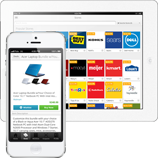Looking Back: Statistics on Black Friday 2010
We’re headed into the 2011 holiday shopping season, and both shoppers and retailers are wondering what to expect this year! Many decisions will likely be made based on last year’s hits and misses, so we’ve compiled some interesting Black Friday 2010 stats to help you know what to expect this year.
The National Retail Federation reports that a whopping 212 million shoppers visited websites and stores during Black Friday and the following Saturday and Sunday. That translates to an increase of 17 million shoppers from 2009!
Other Black Friday statistics posted by the organization:
- Retailers saw a 20% year-over-year increase in sales.
- Shoppers were reportedly spending 17.7 percent more time on department store sites.
- The number of people who purchased jewelry rose substantially, from 11.7% in 2009 to 14.3% in 2010.
- More people purchased gift cards, toys, and books and electronic entertainment in 2010 than they did in 2009.
Consumer Spending Habits
According to ShopperTrak , consumers spent $10.69 billion in retail locations during Black Friday 2010, up only 0.3% from 2009. ShopperTrak records sales and customer traffic at thousands of US malls and stores, and found that customer traffic increased 2.2%. The average amount spent by a consumer was $365.34. Online spending was $648 million on Black Friday, the highest in 2010, and traffic was up 17% to popular Black Friday websites.
Many people were surprised that the number one seller on Black Friday wasn’t Walmart – it was Amazon.com , whose traffic went up by 25% from 2009. Walmart was second, followed by Target and Best Buy.
While many retailers responded positive Black Friday 2010 results, analysts reported that as a whole, the country is still uneasy about spending. The Kellogg Shopper Index, which studies the psychology of shopping, reported that participants who had a significant increase in their income indicated they were planning to spend 16 percent more in holiday gifts in 2010 versus 2009. Those who lost income planned to spend 9 percent less compared to 2009.
Another reason retail analysts report sales rose just 0.3% from 2009: consumers were waiting for the best bargains, perhaps shopping Thanksgiving sales and early Black Friday sales or waiting until holiday sales are released.
”The consumer does seem much more willing to spend when the product and the price is right,” said Roxanne Meyer, a retail analyst for UBS Securities in New York, in a Bloomberg interview. ”But consumers are increasingly waiting closer to Christmas.”
Black Friday Brands on Twitter
There were several brands that received massive exposure on Twitter on Black Friday. Here are the top 10:
BestBuy
@BestBuy
Twitter followers: 107,945
Walmart
@WalmartSpecials
Twitter followers: 90,818
Home Depot
@HomeDepotDeals
Twitter followers: 44,048
Staples
@StaplesTweets
Twitter followers: 85,883
Target
@Target
Twitter followers: 55,359
Sears
@SearsDeals
Twitter followers: 37,448
Macy’s
@MacysInc
Twitter followers: 18,219
Lowe’s
@Lowes
Twitter followers: 13,545
JCPenney
@JCPenney
Twitter followers: 9,662
Kohl’s
@Kohls_Official
Twitter followers: 8,026
Although the major department stores’ Tweets were seen by more people, the most tweeted-about brand on Black Friday was Apple.
Mobile Black Friday Use
Mobile first came onto the Black Friday shopping scene in 2009, as consumers started using it to track bargains, find local stores and to buy products. In 2010 mobile devices were used by 5.6% of shoppers, and were responsible for 3.18% of sales – up 42.60% from 2009!
A survey by PriceGrabber.com found that consumers used their mobile phones largely to shop for LCD TVs, digital SLR cameras, and tablets on Black Friday. They also found that more than one in three holiday shoppers (36 percent) planned to use their mobile devices for shopping-related activities during the 2010 holiday season.
Retailers benefitted from consumers’ increased use of mobile devices. eBay reported that their suite of mobile applications almost doubled their sales over 2009. PayPal saw a 310 percent increase in mobile shopping on Black Friday.
Retailers are expecting even more mobile use during Black Friday 2011, with budget-savvy consumers using their mobile devices to comparison shop for the lowest prices and make purchases from anywhere. In addition, many retailers are websites have great Black Friday apps, which make creating shopping lists, locating stores, and buying products easy.



